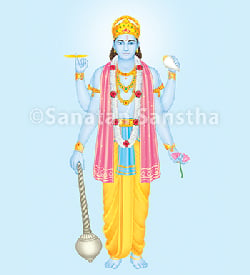
Contents
- Mission and special characteristics
- The deity of nourishment (annarasadevata) [the one who nurtures all living beings]
- The one who loves His devotees (bhaktavatsal)
- The one who often gives promises and remains true to His word
- The one who maintains the balance of the universe
- The stable deity
- The foremost Guru
- The one who converts gross medicine into the subtle aerial form
- Physical features
- Path of Activation of Spiritual Energy (Kundaliniyoga) and Vishnu
- Principle, ability and manifest energy
- The abode, Vishnu’s region (Vishnulok; Vaikunth), Vishnu’s advance (Vishnukram) and the Path of Vishnu (Vishnumarg)
1. Mission and special characteristics
God created the universe through the five deities (principles) – Prajapati, Brahma, Shiva, Vishnu and Minakshi. These five deities have all the characteristics of God besides Their own. Sheshashayi, Anantshayani is Lord Vishnu’s unmanifest (nirgun) form in the Vaishnav sect and is a representation of The Supreme God. Vishnu who loves His devotees is God and the one along with Lakshmi is the Great Illusion (Maya). [In the Shaiva sect, Shiva in the nirbij superconscious state is His unmanifest form or The Supreme God. Shiva in meditation is God and the one in a dancing pose or the one playing a game of dice (saripat) with Parvati is the Great Illusion.] The characteristics correspond to the respective form. The characteristics of God are given in ‘Science of Spirituality : Vol 7. Supreme God, God, Incarnations and Deities’. The other characteristics of Lord Vishnu are given below.
A. The deity of nourishment
(annarasadevata) [the one who nurtures all living beings]
Anna – ad (अन्न – अद्) means that which feeds on living beings and that which living beings feed on is referred to as food. There are quotes like ‘ओषधं अन्नम् ।’ and ‘ओषधे चिन्तयेत् विष्णुम् ।’. ओषध means food, ओषं means oja (precursor of divine energy) and dh-dhru (ध-धृ) means to bear. So oushadh (औषध) means that which carries the radiance in the body. In the verse Vishnusahasranam, vaidya meaning doctor is one of the Names of Lord Vishnu.
B. The one who loves His devotees (bhaktavatsal)
‘Mythologists have greatly glorified Vishnu’s love for His devotees. It was He who rushed to the rescue of the king elephant Gajendra in a crisis and led him to salvation. It is He who assumed the form of Mohini and acquired the nectar (amrut) for the deities during the battle between deities and demons. It was He who placed Dhruv in the infallible position. He alone manifested from a pillar as Nrusinha (the man-lion) for the sake of Prahlad. Sage Durvas had cursed Lord Vishnu’s devotee Ambarish that he would be reborn ten times. For the sake of His disciple’s welfare The Lord took this curse upon Himself. He took the burden of spiritual and worldy problems of His devotees, upon Himself.’
C. The one who often gives promises and remains true to His word
-
न मे भक्त: प्रणश्यति । – श्रीमद्भगवद्गीता ९:३१
Meaning : My devotee never perishes. – Shrimadbhagvadgita 9:31 -
यदा यदा हि धर्मस्य ग्लानिर्भवति भारत ।
अभ्युत्थानमधर्मस्य तदात्मानं सृजाम्यहम् ।। – श्रीमद्भगवद्गीता ४:७Meaning : Whenever there is a deterioration of Righteousness (Dharma) and unrighteousness (adharma) reaches the zenith, I assume an incarnation. – Shrimadbhagvadgita 4:7
D. The one who maintains the balance of the universe
In the Kaliyug man’s temperament is more tama predominant. So, to maintain the balance of the universe it is necessary to increase the sattva component. To increase devotion and decrease the tama component He accomplishes His mission of destroying the evil in society.
धर्मसंस्थापनार्थाय संभवामि युगे युगे ।। – श्रीमद्भगवद्गीता ४:८
Meaning : To deliver the pious and to annihilate the miscreants as well as to re-establish the principle of Righteousness, I incarnate, era after era. – Shrimadbhagvadgita 4:8
E. The stable deity
Vishnu functions without leaving His seat because He exists wherever there are particles of nourishment (annarasa) that is in water, on land, in wood, stone, etc. in other words everywhere.
F. The foremost Guru
It was Vishnu who started the tradition of the Guru and the disciple. Narayan is the first Guru and Narad, the son of Lord Brahma the first disciple. Since the Guru’s very mission is to take His disciple to the Final Liberation (Moksha), it is said that one must seek knowledge from Sadashiv and the Final Liberation from Janardan, that is Vishnu (‘ज्ञानं इच्छेत् सदाशिवात् मोक्षं इच्छेत् जनार्दनात् ।’). (According to the Shaiva sect the Guru-disciple tradition began with Lord Shiva, His first disciple being Vishnu or Parvati.)
G. The one who converts gross medicine into the subtle aerial form
The book ‘Bruhad Nighantu Ratnakar’ give information on the Ayurveda, the science of medicines. The following five types of medicines have been mentioned in it. 1. Medicines from grass, 2. Medicines from the forest, 3. Medicines from living organisms (e.g. algae), 4. Medicines from water and 5. Medicines from the earth. Vishnu converts all these medicines into an aerial form. Consequently medicines in the aerial form are quickly absorbed into the blood stream and therefore into the body cells, that too by mere inhalation.
H. Physical features
-
Complexion : Vishnu has a blue complexion. The blue dot seen during meditation and that of the most subtle divine blue water (nil toya) is that of Vishnu’s blue complexion. [More information on divine blue water is given in ‘Science of Spirituality : Chapter 38 – Path of Activation of Spiritual Energy (Kundaliniyoga).]
-
Garment draped around the waist : It is called a pitambar and is yellow (pit) in colour.
I. Path of Activation of Spiritual Energy (Kundaliniyoga) and Vishnu
The Vishnu gland is situated close to the Anahat chakra. [Refer ‘Science of Spirituality : Chapter 38 – Path of Activation of Spiritual Energy (Kundaliniyoga).]
J. Principle, ability and manifest energy
-
Principle : 100 % [God (Ishvar) = 100 %]
Refer ‘Science of Spirituality : Vol. 7 Supreme God, God, Incarnations and Deities, point – Proportion of characteristics of The Supreme God in animate and inanimate creation’. -
Ability : The basic functions are creation, sustenance and dissolution. With reference to Vishnu they are 2%, 96% and 2% respectively.
-
Manifest energy : Like God, Vishnu too utilises only 10% of His energy to carry out His mission. This energy is referred to as the manifest energy. That energy which is dormant is called unmanifest energy. If according to the mission more energy is required then the manifest energy is more.
2. The abode, Vishnu’s region
(Vishnulok; Vaikunth), Vishnu’s advance
(Vishnukram) and the Path of Vishnu (Vishnumarg)
A. The abode
Vishnu lives only with His devotees. It can be explained in flowery language as follows: Vishnu’s abode is in Vishnu’s region (Vaikunth). Lakshmi, Vishnu’s wife is the daughter of the king of hell (patal). Hence Vishnu goes and lives in the celestial ocean (kshirasagar). Yet His real abode is where His devotees sing His glory.
मद्भक्ता: यत्र गायन्ति तत्र तिष्ठामि नारद ।।
Meaning : O Narad, I neither live in Vaikunth nor in the hearts of yogis. I reside wherever My devotees sing My glory.
B. Vishnu’s region (Vishnulok; Vaikunth)
That from which all impurity has disappeared is Vaikunth. Vaikunth means Blissful. Vaikunth itself is the region of Lord Vishnu (विकुंठा – विगत: कुंठ: यस्मात् ।). It is above the seven heavens and is divinely beautiful. Jai-Vijay are the gatekeepers of Vaikunth and allow only devotees of Lord Vishnu to enter it. A river named Viraja flows through Vaikunth. Devotees of Vishnu who live in Vaikunth sit on the banks of this river and undertake spiritual practice. Since Vishnu possesses the basic components of all foods, splendour of all sorts is present in His region. There are also musicians who play stringed musical instruments. The celestial musicians (gandharvas), demigods (yakshas) and celestial singers (kinnars) go to Vishnu and sing. However the demigods consider Shiva as their main deity.
C. Vishnu’s advance (Vishnukram)
‘In the Brahman age Vishnu’s three footsteps have been clearly associated with the earth, space and akash (absolute ether). This is referred to as Vishnu’s advance.’ Space is the part between two regions, (for example between the earth and heaven). Akash is a hollow, even the hollow between two most subtle particles.
D. Path of Vishnu (Vishnumarg) – Path of The Creator
In the vast universe there is a ‘zero stress nature (shunya marg) ’ extending from the Vishnu region to patal (hell). That itself is referred to as the Path of Vishnu. If one travels upon it there is no friction. Narad can travel along this path; hence He is able to reach the earth or hell from Vishnu’s region within a moment. Refer ‘Science of Spirituality : Vol. 7 – Supreme God, God, Incarnations and Deities’ point ‘Path of destiny and that of The Creator’.
Reference : Sanatan Sanstha’s Holy text ‘Vishnu and His forms’

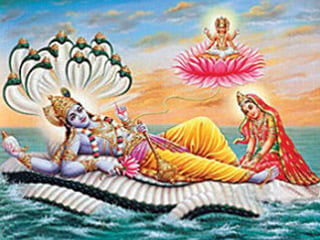
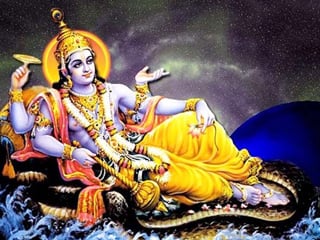 What are the implied meanings of the ten incarnations of Lord Vishnu ?
What are the implied meanings of the ten incarnations of Lord Vishnu ?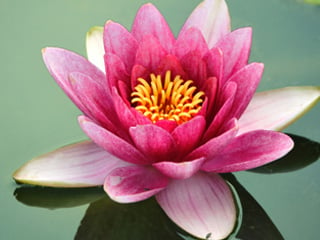 What does the lotus in the hand of Lord Vishnu symbolize?
What does the lotus in the hand of Lord Vishnu symbolize?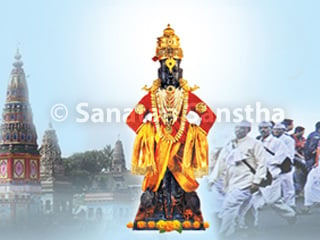 What does the idol of Lord Vitthal with His hands on the waist signify?
What does the idol of Lord Vitthal with His hands on the waist signify?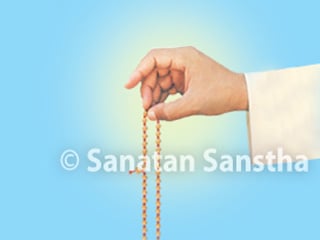 Why should one chant specific Lord Vishnu mantra for accomplishing a particular mission?
Why should one chant specific Lord Vishnu mantra for accomplishing a particular mission?